Shopify Setup
Integration
Integrate the out-of-the-box way!
This page serves as a guide on how to integrate using our out-of-the-box solution. The Shopify Customization page shows integration using custom solutions, such as a Custom App and Custom Web Integration. You can use different options when integrating Bloomreach and Shopify.
Watch the video below to see how to integrate Shopify with Bloomreach Engagement in a few simple steps.
1. Add new integration
Open the Bloomreach Engagement App and go to Data & Assets > Integrations > + Add new integration and look up Shopify. Next, click on + Add integration.

Ensure you have all prerequisites from the Shopify and Shopify Plus Overview prerequisites section.
2. Connect your project with Shopify
To connect your project with Shopify, there are two ways to authenticate with Shopify and allow the data to flow successfully.
The next section is about connecting your project with Shopify using the Official App - available in the Shopify App Store. For a guide how to connect your project using a Custom App, click here.
Official App
- After reviewing the prerequisites, connect your project with Shopify via the Official App. To generate Encrypted credentials, click on the
official App in the Shopify App Storelink, which redirects you to the Shopify App Store.

- Click on
Add app, then approve permissions by clicking theInstall appbutton.
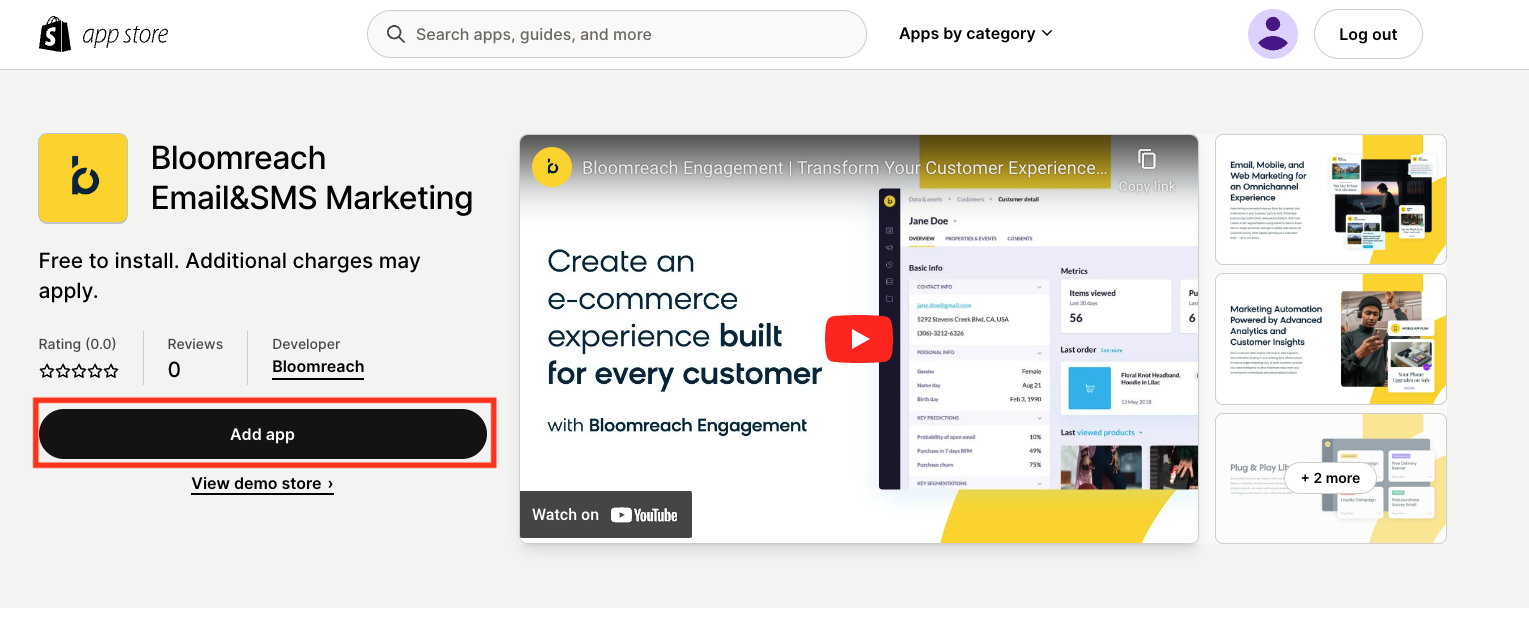
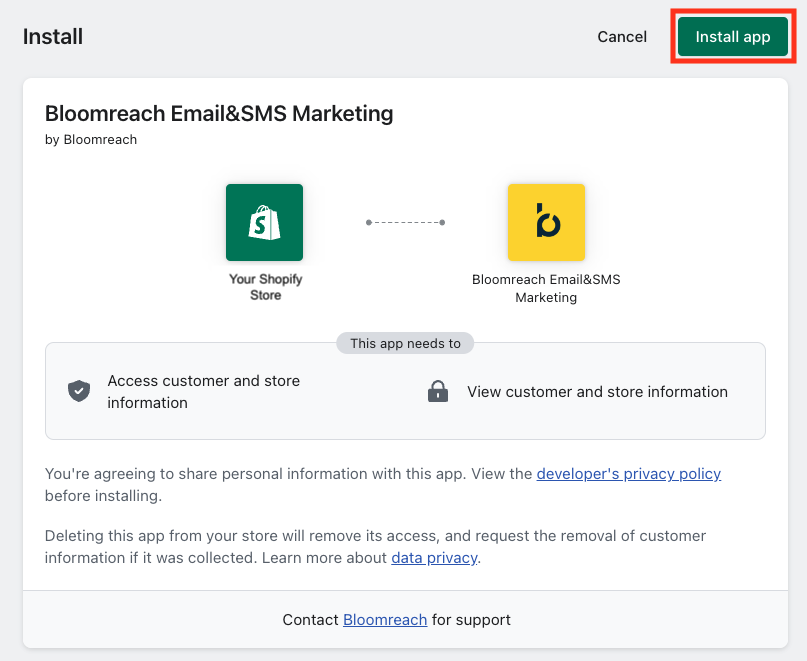
- To connect your Shopify account with Bloomreach Engagement, click the
Reveal tokenbutton and copy and paste it into the Encrypted credentials field in Bloomreach Engagement.
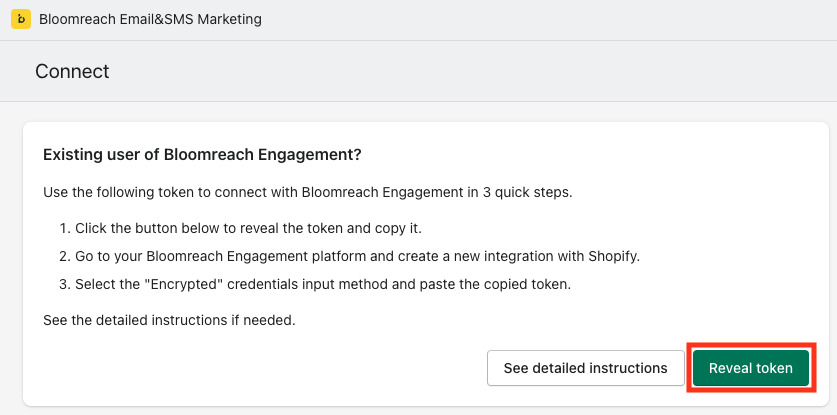

3. Web integration
The next section is about tracking frontend events (such as view_item, view_category, etc.) using a Shopify Web Pixel. For a guide how to track frontend events using Custom Web Integration click here.
Main differences between Custom Web integration and Shopify Web Pixel
- Attributes not tracked by webpixel:
view_category: browser, device, location and os
view_item: browser, device, location and os
search: browser, device, location and os
checkout: browser, device, location and os
Checkout event is triggered when any of the checkout steps is changed:
checkout_started,checkout_contact_info_submitted,checkout_address_info_submitted,checkout_shipping_info_submitted,checkout_completedIn the checkout event the
step_titleattribute is changed to be representative of the checkout state, so for examplestep_titlethankyoubecomescheckout_completed.
We take thesestep_titleattributes from checkout event names.Checkout tracking is supported only by the Shopify Web Pixel due to changes on Shopify's side.
Shopify Web Pixel
Prerequisites
Shopify Web Pixel is part of our official app in the Shopify App Store. That's why this method is supported only via the Authorization method through the Official App (Shopify App Store).
A single store can only have one web-pixel integration. This usually means 1 project = 1 integration = 1 pixel. You won't be able to create 2 web pixel integrations on the same store (and the same app).
Important
The Bloomreach Engagement Web Pixel requires "Marketing and Analytics" consent to send data to Bloomreach. Make sure you have this consent category set up in your cookie acceptance banner, whether you use Shopify Native or another provider. If you're not seeing
view_item,view_category, orsearchevents, check that your website sets the correct cookie acceptance policies.
Integrating with Web Pixel
- You need to add the Bloomreach Web Integration snippet to your Shopify store. Access the Themes tab and click on ⋯ Edit code to insert the snippet.
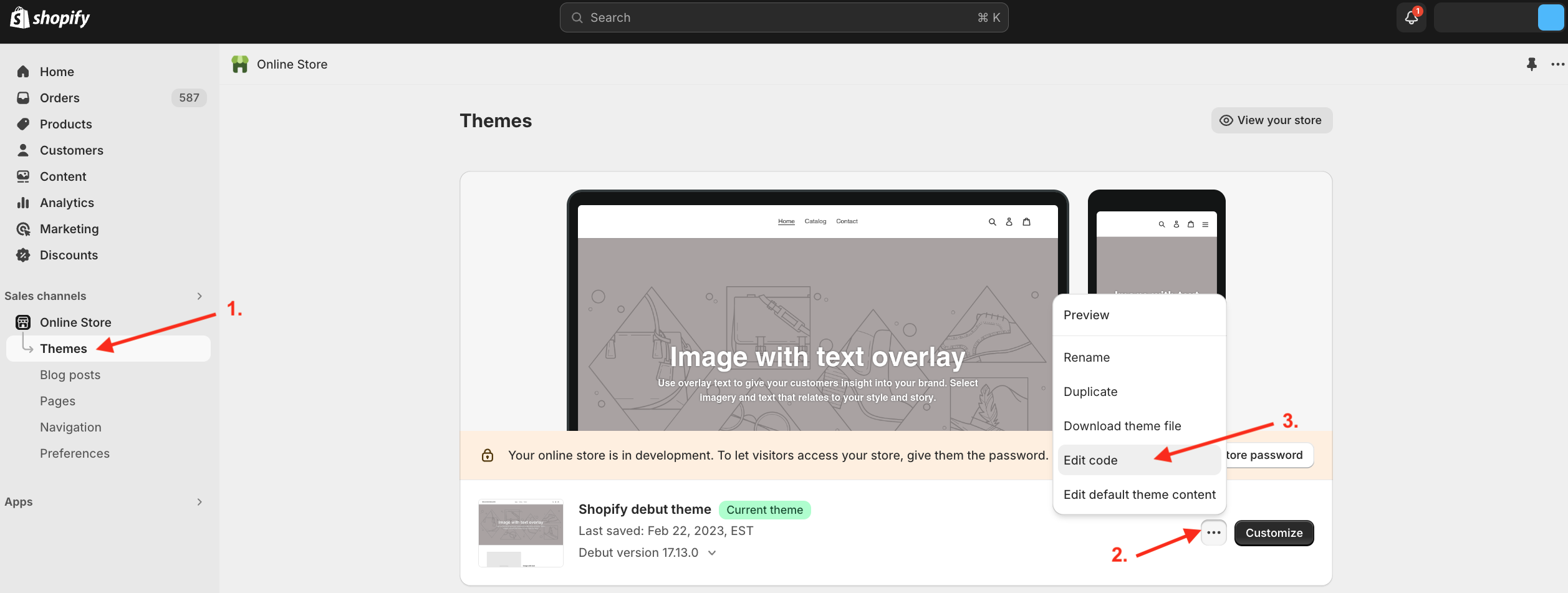
- Open the theme.liquid file.
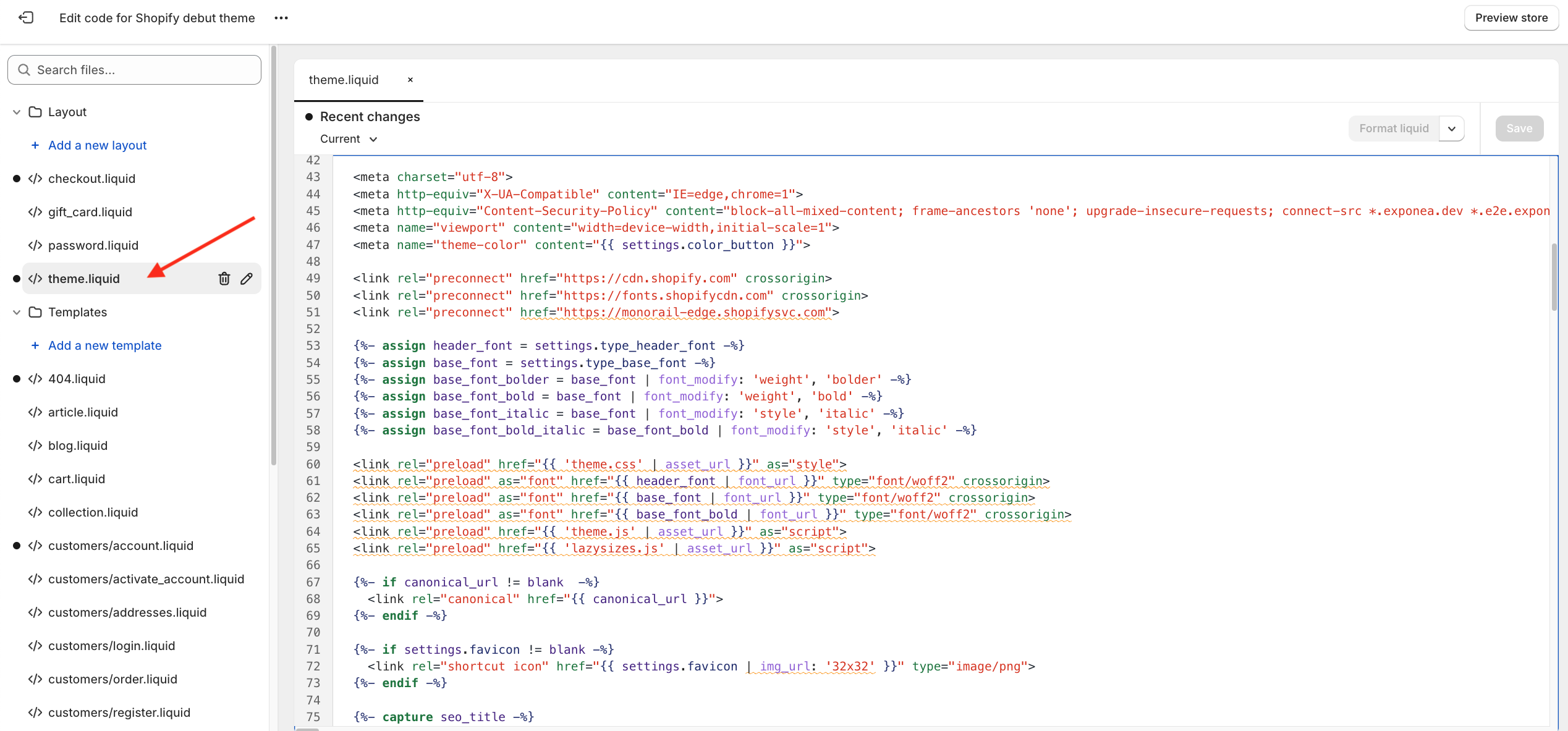
- Copy the following data-layer snippet and paste it on a new line above the closing header tag
</head>inside your theme.liquid file.
<script>
window.dataLayer = window.dataLayer || [];
function subscribeCookieListener(dataLayer) {
// Step to process information already existing in the datalayer
dataLayer.forEach(processDatalayerEvent)
// Set-up a "listener"
const originalPush = dataLayer.push;
dataLayer.push = function() {
originalPush.apply(dataLayer, arguments);
Array.from(arguments).forEach(processDatalayerEvent);
};
}
subscribeCookieListener(window.dataLayer);
function processDatalayerEvent(event){
if(event.event === "bre.cookie"){
Shopify.analytics.publish("bre.cookie",event);
}
}
</script>
- Now go to your project in Bloomreach, click on Web integration, and decide whether you want to track
page_visitevents. If yes, tick the relevant checkbox.
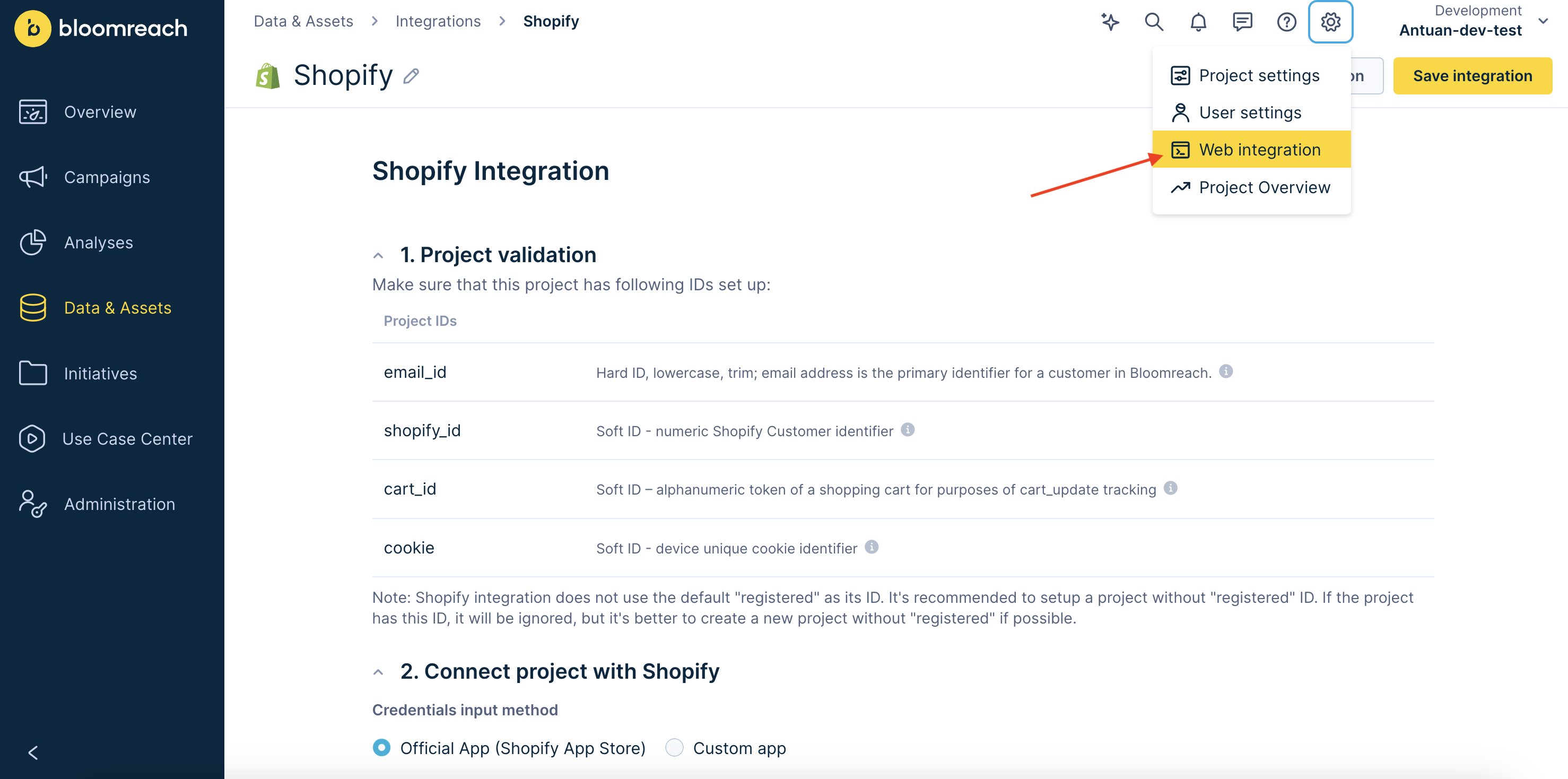
- Hit Copy to clipboard button and paste the snippet from Bloomreach Engagement directly under the data-layer script in your Shopify theme.liquid file.
- Additionally, copy the following line data_layer: true. Place it below the
tokenparameter and ensure they are on the same hierarchical level. This exposes the cookie and its changes to the dataLayer object for use in other tools, like Google Tag Manager. If set to false or omitted, dataLayer won't be updated.
data_layer: true,
- Then, replace
exponea.start();with the following code:
function getCookie(cname) {
var name = cname + "=";
var ca = document.cookie.split(';');
var cookie = undefined;
for (var i = 0; i < ca.length; i++) {
var c = ca[i];
while (c.charAt(0) == ' ') {
c = c.substring(1);
}
if (c.indexOf(name) == 0) {
cookie = c.substring(name.length, c.length);
break;
}
}
cookie = decodeURIComponent(cookie);
cookie = cookie.split('?')[0];
return cookie;
}
var customer = {};
var cart_id = getCookie('cart');
if (cart_id) customer.cart_id = cart_id;
{% if customer and customer.email %}
customer.email_id = {{ customer.email | json }};
customer.shopify_id = {{ customer.id | json }};
{% endif %}
exponea.start({
"customer": customer
});
To clarify, here's an example of the Web Integration snippet. Make sure to specify your target and token.
<script>
window.dataLayer = window.dataLayer || [];
function subscribeCookieListener(dataLayer) {
// Step to process information already existing in the datalayer
dataLayer.forEach(processDatalayerEvent)
// Set-up a "listener"
const originalPush = dataLayer.push;
dataLayer.push = function() {
originalPush.apply(dataLayer, arguments);
Array.from(arguments).forEach(processDatalayerEvent);
};
}
subscribeCookieListener(window.dataLayer);
function processDatalayerEvent(event){
if(event.event === "bre.cookie"){
Shopify.analytics.publish("bre.cookie",event);
}
}
</script>
<script>
!function(e,n,t,i,r,o){function s(e){if("number"!=typeof e)return e;var n=new Date;return new Date(n.getTime()+1e3*e)}var a=4e3,c="xnpe_async_hide";function p(e){return e.reduce((function(e,n){return e[n]=function(){e._.push([n.toString(),arguments])},e}),{_:[]})}function m(e,n,t){var i=t.createElement(n);i.src=e;var r=t.getElementsByTagName(n)[0];return r.parentNode.insertBefore(i,r),i}function u(e){return"[object Date]"===Object.prototype.toString.call(e)}o.target=o.target||"https://api.exponea.com",o.file_path=o.file_path||o.target+"/js/exponea.min.js",r[n]=p(["anonymize","initialize","identify","getSegments","update","track","trackLink","trackEnhancedEcommerce","getHtml","showHtml","showBanner","showWebLayer","ping","getAbTest","loadDependency","getRecommendation","reloadWebLayers","_preInitialize","_initializeConfig"]),r[n].notifications=p(["isAvailable","isSubscribed","subscribe","unsubscribe"]),r[n].segments=p(["subscribe"]),r[n]["snippetVersion"]="v2.7.0",function(e,n,t){e[n]["_"+t]={},e[n]["_"+t].nowFn=Date.now,e[n]["_"+t].snippetStartTime=e[n]["_"+t].nowFn()}(r,n,"performance"),function(e,n,t,i,r,o){e[r]={sdk:e[i],sdkObjectName:i,skipExperiments:!!t.new_experiments,sign:t.token+"/"+(o.exec(n.cookie)||["","new"])[1],path:t.target}}(r,e,o,n,i,RegExp("__exponea_etc__"+"=([\\w-]+)")),function(e,n,t){m(e.file_path,n,t)}(o,t,e),function(e,n,t,i,r,o,p){if(e.new_experiments){!0===e.new_experiments&&(e.new_experiments={});var l,f=e.new_experiments.hide_class||c,_=e.new_experiments.timeout||a,g=encodeURIComponent(o.location.href.split("#")[0]);e.cookies&&e.cookies.expires&&("number"==typeof e.cookies.expires||u(e.cookies.expires)?l=s(e.cookies.expires):e.cookies.expires.tracking&&("number"==typeof e.cookies.expires.tracking||u(e.cookies.expires.tracking))&&(l=s(e.cookies.expires.tracking))),l&&l<new Date&&(l=void 0);var d=e.target+"/webxp/"+n+"/"+o[t].sign+"/modifications.min.js?http-referer="+g+"&timeout="+_+"ms"+(l?"&cookie-expires="+Math.floor(l.getTime()/1e3):"");"sync"===e.new_experiments.mode&&o.localStorage.getItem("__exponea__sync_modifications__")?function(e,n,t,i,r){t[r][n]="<"+n+' src="'+e+'"></'+n+">",i.writeln(t[r][n]),i.writeln("<"+n+">!"+r+".init && document.writeln("+r+"."+n+'.replace("/'+n+'/", "/'+n+'-async/").replace("><", " async><"))</'+n+">")}(d,n,o,p,t):function(e,n,t,i,r,o,s,a){o.documentElement.classList.add(e);var c=m(t,i,o);function p(){r[a].init||m(t.replace("/"+i+"/","/"+i+"-async/"),i,o)}function u(){o.documentElement.classList.remove(e)}c.onload=p,c.onerror=p,r.setTimeout(u,n),r[s]._revealPage=u}(f,_,d,n,o,p,r,t)}}(o,t,i,0,n,r,e),function(e,n,t){var i;e[n]._initializeConfig(t),(null===(i=t.experimental)||void 0===i?void 0:i.non_personalized_weblayers)&&e[n]._preInitialize(t),e[n].start=function(i){i&&Object.keys(i).forEach((function(e){return t[e]=i[e]})),e[n].initialize(t)}}(r,n,o)}(document,"exponea","script","webxpClient",window,{
target: "YOUR INSTANCE",
token: "YOUR TOKEN",
data_layer: true,
experimental: {
non_personalized_weblayers: true
},
// replace with current customer ID or leave commented out for an anonymous customer
// customer: window.currentUserId,
track: {
visits: true,
google_analytics: false,
},
});
function getCookie(cname) {
var name = cname + "=";
var ca = document.cookie.split(';');
var cookie = undefined;
for (var i = 0; i < ca.length; i++) {
var c = ca[i];
while (c.charAt(0) == ' ') {
c = c.substring(1);
}
if (c.indexOf(name) == 0) {
cookie = c.substring(name.length, c.length);
break;
}
}
cookie = decodeURIComponent(cookie);
cookie = cookie.split('?')[0];
return cookie;
}
var customer = {};
var cart_id = getCookie('cart');
if (cart_id) customer.cart_id = cart_id;
{% if customer and customer.email %}
customer.email_id = {{ customer.email | json }};
customer.shopify_id = {{ customer.id | json }};
{% endif %}
exponea.start({
"customer": customer
});
</script>
- Save the changes in the liquid.file, and navigate back to your Bloomreach project.
Snippets order
Bear in mind that the order of snippets matters.
- Finish the web integration
Enable the flows you want to track.

- Save integration, and your Web Integration is done!

4. Manage consents
In this step, you decide how to integrate your consents from Shopify into Bloomreach. Learn more about the Shopify Marketing consents.
Shopify has two marketing channels: Email and SMS.
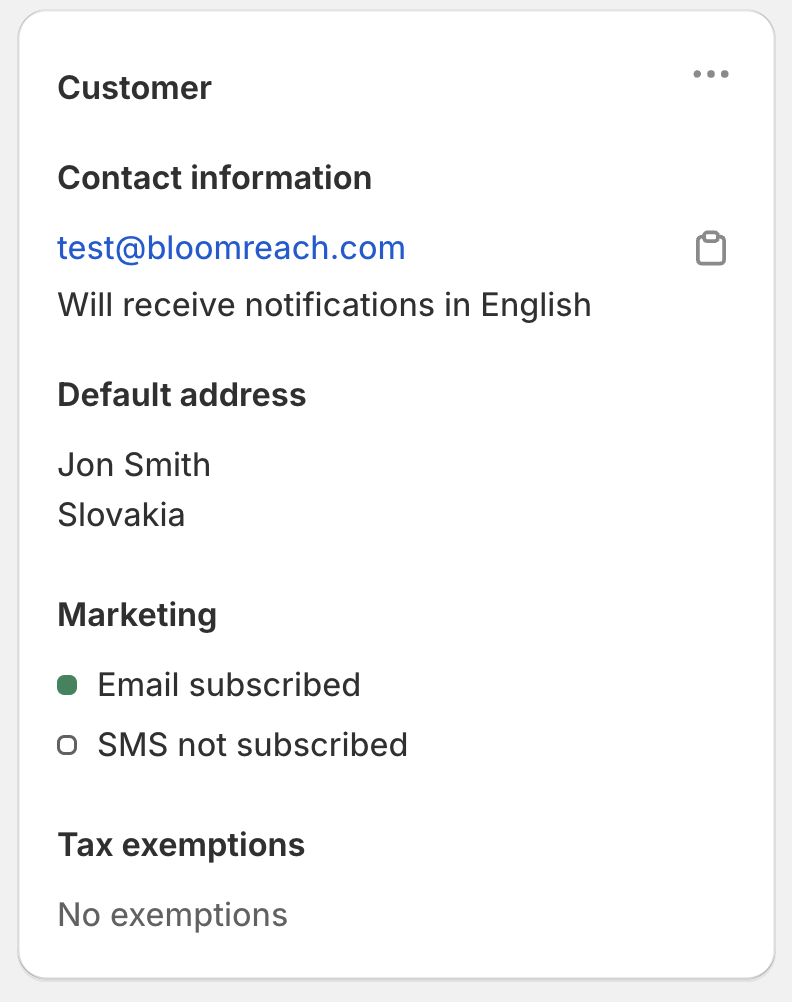
Your consent setup for the Shopify integration will depend on whether or where you are managing your Marketing double opt-in.
Double opt-in management via Shopify
If it is managed via Shopify, you can map Shopify Marketing Consents to Bloomreach Consent, as showcased below. This means that we will create a Bloomreach Consent event for each consented customer.
Shopify setup

Bloomreach setup
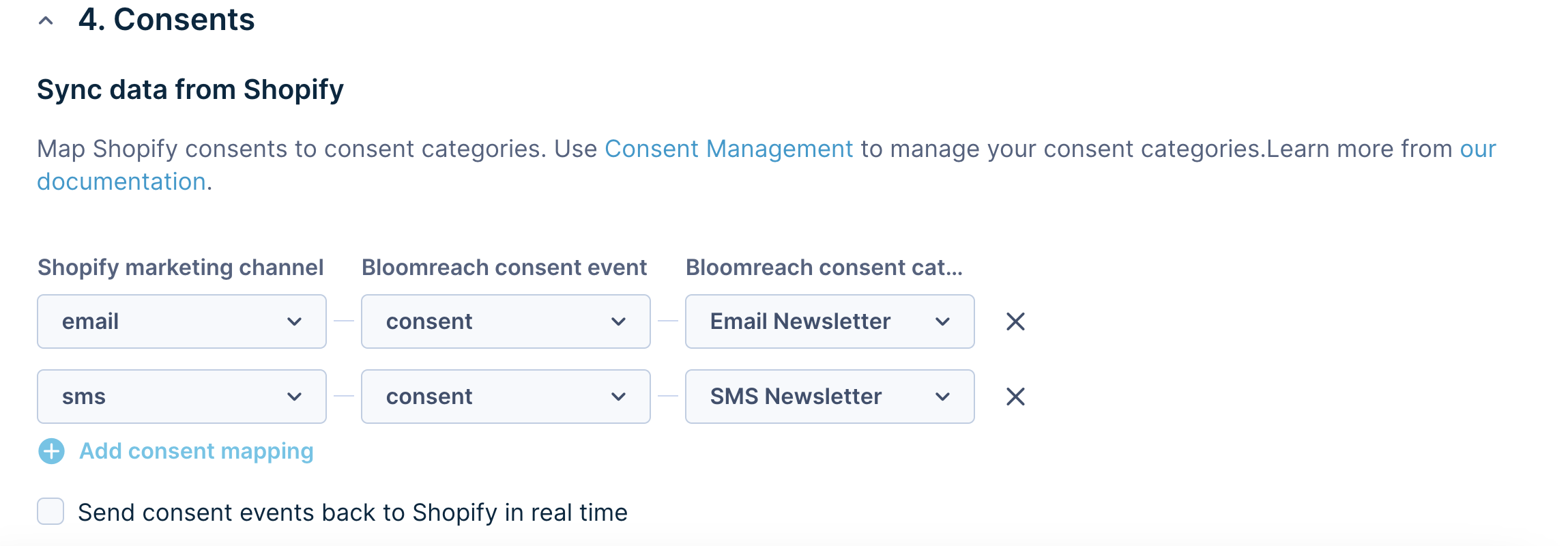
Double opt-in management via Bloomreach
If you want to manage double opt-in via Bloomreach, choose the following setup: When a customer subscribes to your communication, a new double_opt_in event will appear in Bloomreach, which can be used to trigger a double opt-in scenario. Learn how to create a double opt-in scenario inside Bloomreach here.
Shopify setup
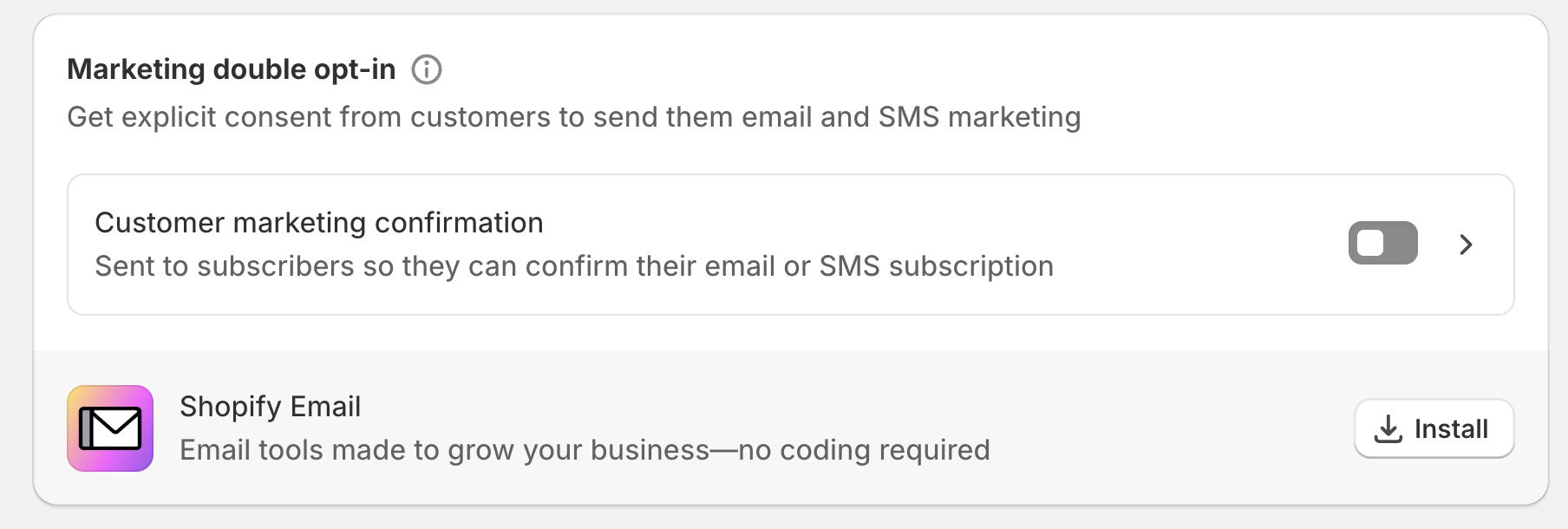
Bloomreach setup

The last option for the Bloomreach consent event is shopify_consent. Selecting it will create a shopify_consent event with each change of consent for your customers. This option is dedicated to users willing to create custom scenarios to process their customer consents.
A Bloomreach consent category must be assigned for both the consent and double_opt_in consent events. Please be aware that you must map only one Bloomreach Consent Category for each Shopify Marketing Chanel.
The last step of the consent management setup is deciding about the bidirectional sync (Bloomreach to Shopify). This can be done by ticking the Send consent event back to Shopify in the real-time checkbox. Enabling this feature means that all consent changes made on the Bloomreach side will be reflected inside Shopify. We support only official consent statuses - accept and reject. We recommend enabling this feature to keep consents in sync between both platforms. Be aware that the integration will not be able to grant SMS consent “Subscribed” status for Customers without a phone number inside the Shopify Admin view.
5. Additional settings
Product tags
If you use Product Tags in Shopify, we recommend bringing them to Bloomreach to power the recommendation engine with additional product data or enrich your analytics with product insights.
Naming convention of the Shopify Product Tags
To match Bloomreach Catalogues structure, we recommend using the following naming convention structure for the Shopify Product Tags:
name_of_the_tagany separator (, - _ ;), and then value, for example,gender_unisex,collection-winter,promo_code=Sale15.If you want to, for example, add a tag
color_#808080, usecoloras the tag's name and_as a separator. In this case, the Shopifycolor_#808080will be displayed in a catalog as a columnproduct_tag_colorand value#808080. If you add the wholecolor_#808080as a name of the tag, it won't work correctly.
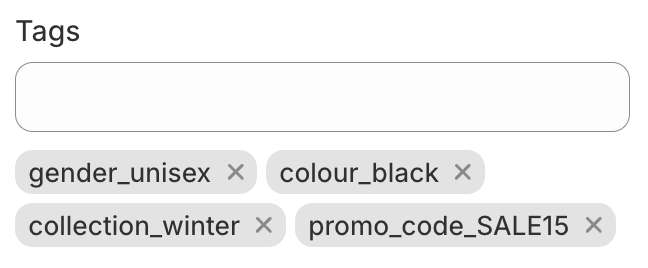
Once you decide which product tags you want to bring to Bloomreach, place them in the Additional Settings section under the Product Tags.
- Tag value = name of your tag, such as:
color,gender,promo_code. - Separator = sign separating tag from the value, such as:
_ , - =. - Searchable = marks this field as searchable inside catalogs, recommendations, etc.
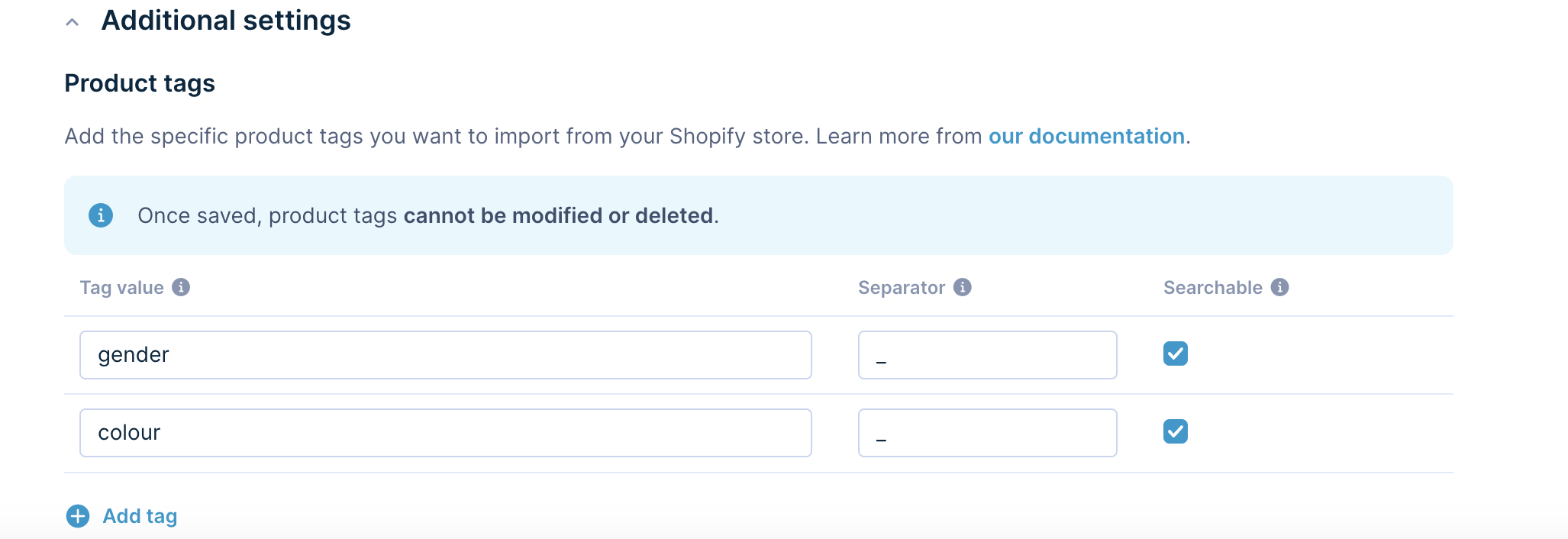
Selected product tags will be visible inside the product catalogs and will be part of the purchase_item events.
Frequency of adding new product tags
Every time the configuration is saved with new product tags, it will reimport all catalogs to add those fields (which can take some time). Please be aware that new product tags shouldn’t be added frequently.
Product metafields
We recommend importing your Product Metafields from Shopify into Bloomreach. This process can enhance your recommendation engine with more comprehensive product data and enrich your analytics with deeper product insights.

We support the following metafield data types:
boolean,color,date,date_time,multi_line_text_field,number_decimal,number_integer,single_line_text_fieldandurl.
Once you decide which product metafields you want to bring to Bloomreach, you need to place them in the Additional Settings section under the Product Metafields.

To find the Metafield key go to your Shopify store's Settings > Custom Data > Products > Product metafield definition and copy the value from the Namespace and key field.
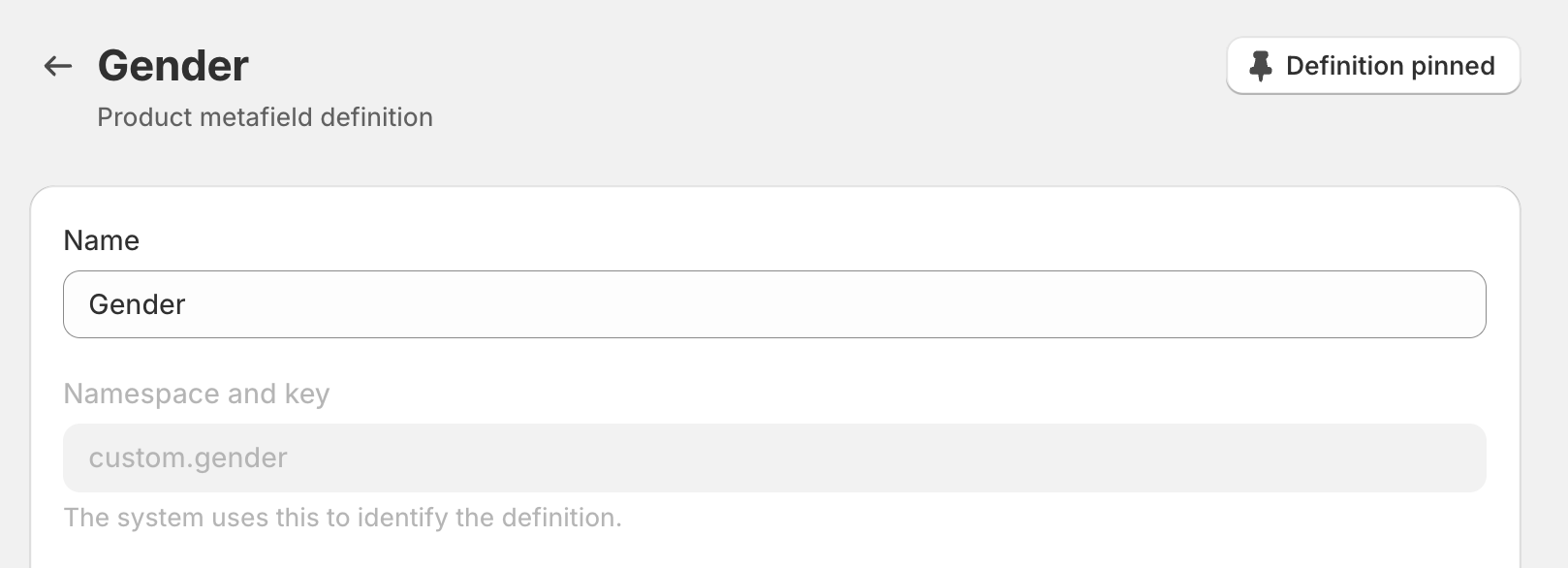
Example - custom.gender
Selected product metafields are visible inside the product catalogs and are a part of the purchase_item events.
Limit of searchable fields
The number of searchable attributes is limited and shared across settings like Product metafields and Product catalogs.
Select up to 20 fields (including Product metafields and Product tags) to bring to Bloomreach.
Once saved, the configuration cannot be modified or deleted.
6. Save the integration
Once you save the integration, events will start appearing in your project. This part ensures that Shopify data flows into Bloomreach Engagement after setup.
Warning: Don't delete Shopify catalogs
Deleting catalogs created by the Shopify integration will break your integration and cause sync failures.
If you need to modify catalogs, contact Bloomreach Support with your integration details and requirements.
Regular catalog imports and customer and historical purchase data can be found in Bloomreach Engagement under Imports.
Take a coffee break before all the imports are visible, as the whole import might take a while to finish. The progress bar allows you to track the progress of the initial import.

If you face any issues, please follow the recommended steps.

Reimport
The Reimport functionality allows you to Reimport your catalogs, customers, and historical events.

Triggering the Reimport function does not automatically delete previously imported events; it brings them back into the project, which can lead to duplication. To avoid this, remove previously imported Shopify events from the project.
Follow the steps in the Delete events and properties article.
Shopify events to be deleted:
- purchase
- Purchase_item
- Consent
- Shopify_consent
- _customer_change
To identify events coming from the Shopify integration, use the domain attribute to filter them out.
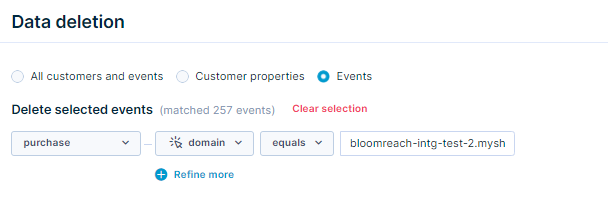
Removing Shopify integration
If you decide to remove Shopify integration, please do not manually remove the webhook from the integration before removing the integration in the application, as you cannot remove the integration afterward. Instead, use only the 'Remove Integration' button in the application. It will take care of all steps required to remove the integration, including deleting the webhook.
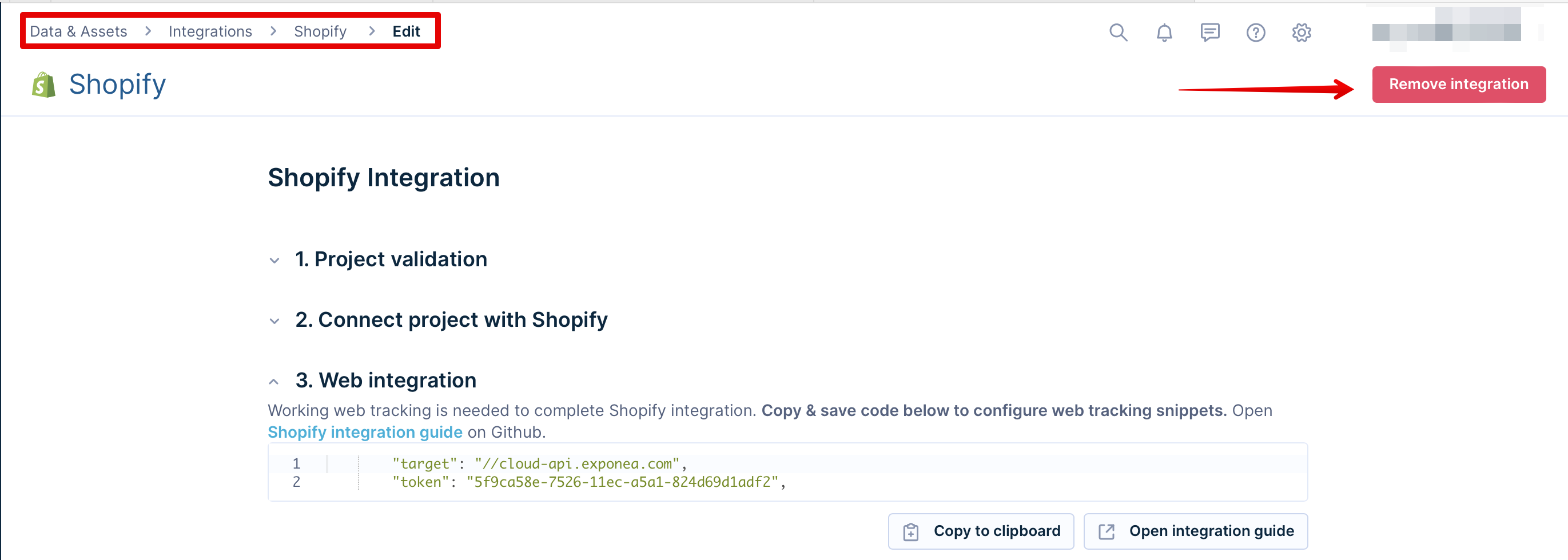
Troubleshooting
If you encounter any problems, ensure that you are running the most recent version of Shopify.
Shopify Updates
If you use an older version, a warning message will appear in the Shopify Admin. To continue using the Shopify integration and access the latest features, we strongly recommend updating to the most recent version in Shopify Admin by clicking the update button.
Updated 3 months ago
